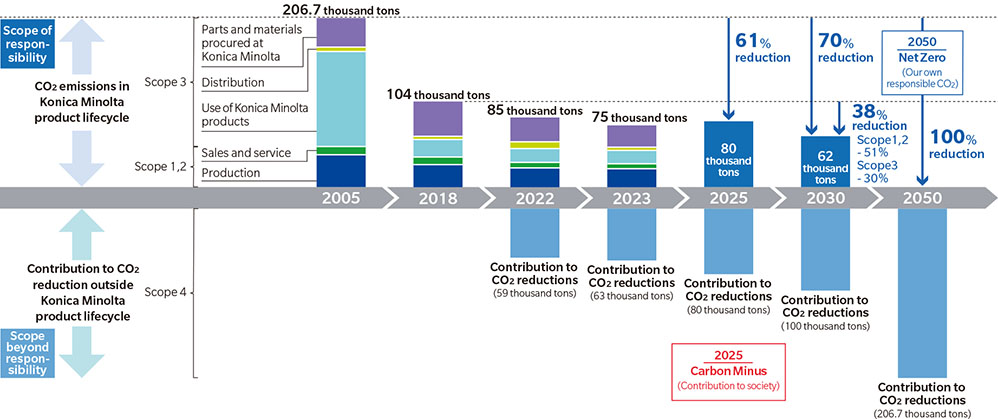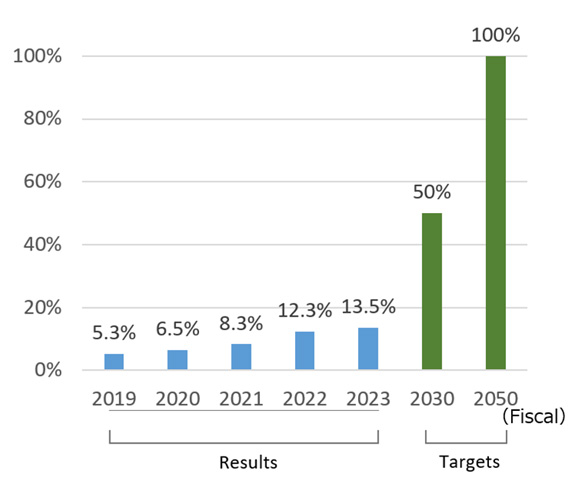Climate-related Financial Information Disclosure (TCFD)
Metrics and Targets
Metrics and Targets Used to Assess and Manage Climate-related Risks and Opportunities
Konica Minolta seeks to achieve Carbon Minus status by actively helping to reduce global CO2 emissions in cooperation with its stakeholders, especially suppliers and customers. The Group defines Carbon Minus status as a state in which the amount of CO2 reduction contributed outside its scope of responsibility exceeds the CO2 emissions within its scope of responsibility (Scope 1, 2, and 3 emissions). Konica Minolta has also set a "net-zero" target for CO2 emissions within its scope of responsibility to achieve the Paris Agreement. The Group aims to fulfill its corporate social responsibility, support stakeholders in their social responsibility efforts, and grow together.
Note:
・Scope 1: Direct emissions from the company, such as those from the use of fuel.
・Scope 2: Indirect emissions resulting from the use of electricity, heat, and steam supplied by other companies.
・Scope 3: Emissions related to the company's business activities within the value chain, including raw material procurement, logistics, and product use.
・Scope 4: This refers to CO2 emission reduction contributions achieved by our solutions at societal and customer sites, outside of Scopes 1, 2, and 3. The Company quantifies these contributions based on its unique definitions.
Carbon Minus and Net Zero Targets

(For more information on targets and results, please refer to Sustainability Targets and Results)
For detailed data, please refer to the Environmental Data (Excel) on the ESG Data page.
1. Greenhouse Gas Emissions (Scope 1, 2, and 3 Emissions)
Konica Minolta uses product lifecycle CO2 emissions, as a metric for managing climate change risks and has established reduction targets accordingly. Product lifecycle CO2 emissions include all Scope 1 and 2 emissions (generated during the production, sales, and service stages) and the main components of Scope 3 emissions (from procurement, distribution, and product use stages).
In the short term, Konica Minolta aims to reduce emissions by 61% (800 thousand tons) compared to fiscal 2005 levels by 2025, and in the medium term, by 70% (620 thousand tons) by 2030. In fiscal 2024, CO2 emissions were approximately 784 thousand tons (148 thousand tons from Scope 1, and 123 thousand tons from Scope 2, and 513 thousand tons from major Scope 3 categories), achieving a 62% reduction.
In the long term, Konica Minolta has set a goal to achieve net-zero greenhouse gas emissions across its entire value chain by 2050.
The Company obtains third-party assurance annually for various non-financial performance indicators, including CO2 emissions (Scope 1, Scope 2, and some Scope 3 emissions), through its Environmental and Social Data report to ensure the validity of the data. The third-party assurance for fiscal year 2024 data is currently underway.
CO2 Emissions in the Product Llifecycle (Scopes 1, 2, and 3)

(Unit: thousand tons-CO2)
| Results | Targets | |||||||||
|---|---|---|---|---|---|---|---|---|---|---|
| FY 2005 (Base year) |
FY 2018 |
FY 2021 |
FY 2022 |
FY 2023 |
FY 2024 |
FY 2025 |
FY 2030 |
|||
| Product lifecycle CO2 emissions | 2,067 | 1,041 | 790 | 851 | 748 | 784 | 800 | 620 | ||
| Scope 1 (Production, sales and service) | 254 | 170 | 159 | 151 | 148 | 148 | - | 170 | ||
| Scope 2 (Production, sales and service) | 220 | 197 | 164 | 151 | 139 | 123 | ||||
| Scope 3 (Procurement, distribution, product) | 1,592 | 675 | 467 | 548 | 462 | 513 | - | 450 | ||
| Category 1 (Purchased goods and services) | 397 | 437 | 247 | 296 | 272 | 314 | ||||
| Category 4 (Upstream transportation and distribution, of which, distribution of products) | 58 | 26 | 41 | 83 | 28 | 53 | ||||
| Category 11 (Use of sold products) | 1,137 | 211 | 179 | 169 | 162 | 147 | ||||
- Note: Figures may not add up due to rounding.
2. Transition Risk
Konica Minolta has adopted the ratio of electricity derived from renewable energy, as a key metric for managing transition risks. The Company has set a target of sourcing 100% of the electricity used in its business operations from renewable energy by 2050. In the medium term, it aims to increase this ratio to more than 50% by 2030.
In the Business Technologies Business, which accounts for approximately 80% of the Konica Minolta Group’s total revenue, Konica Minolta views stakeholder expectations regarding renewable energy procurement as a business risk. The Company has positioned this issue as a priority and is advancing initiatives accordingly. It has achieved and continues to maintain 100% renewable energy use at all overseas production sites for multifunctional peripherals (MFPs).
In fiscal 2024, the ratio of electricity derived from renewable energy rose to approximately 20%, driven by the full-scale use of renewable energy at our production and R&D sites in Japan.
Ratio of electricity derived from renewable energy

3. Physical Risk
The Business Technologies Business, the Group’s core business, delivers products to customers in 150 countries around the world. To prevent disruptions in product supply to customers caused by supply chain disruptions due to large-scale natural disasters, Konica Minolta tracks raw material supply routes back to crude materials. For raw materials with a high risk of unstable supply, the Company is working to secure multiple suppliers and to consider alternative materials.
In addition, to prepare for such a disaster risk, the Group is working to ensure a highly resilient supply chain structure that can supply products at the place of consumption by developing multiple Konica Minolta sites in Japan, Europe, and North America to produce and supply parts for consumables in the Professional Print Business and the Office Business, as well as printing toner.
4. Climate-related Opportunity
Konica Minolta has adopted both economic and environmental value as metrics for managing climate-related opportunities and has set corresponding targets. These values are created through providing of the Company’s products and solutions to stakeholders.
For economic value, the Company uses two indicators: sales of Green Products that contribute to addressing climate change, and the ratio of Green Product sales to total revenue.
- (For details on Green Products, please see here: the Green Products Certification System)
For environmental value, the Company uses two metrics: “CO2 reduction during product usage” (reductions in Scope 3 emissions through energy-saving design and development of Konica Minolta products), and “contributions to CO2 reduction outside the Konica Minolta product lifecycle” (contribution to reductions in Scope 4 emissions through solutions that transform customers’ production processes).
In fiscal 2024, to increase CO2 reduction contributions, Konica Minolta expanded sales of digital printers in the Professional Print Business that improve productivity by transforming work processes from analog to digital printing.
| Management Metrics | Results | Targets | |||
|---|---|---|---|---|---|
| FY2023 | FY2024 | FY2024 | FY2025 | ||
| Economic value | Green Products Sales (billion yen) | 773 | 777 | - | 735 |
| Percentage of green product sales (%) | 67 | 69 | - | 70 | |
| Environmental value | CO2 emissions during product Use (thousand tons) | 73 | 133 | 146 | 190 |
| Contribution to CO2 reduction outside the Konica Minolta product lifecycle (thousand tons) | 631 | 682 | 690 | 800 | |
5. Capital Deployment
Konica Minolta has identified “addressing climate change” as one of the five material issues to be tackled under its long-term management vision. The Company is allocating capital to business activities that contribute to enhancing corporate value and realizing a low carbon society over the medium to long term.
In fiscal 2024, R&D expenses for projects that contribute to addressing climate change (such as CO2 reduction efforts) totaled 30.7 billion yen, accounting for approximately 51% of the Konica Minolta Group’s total R&D expenses.
6. Internal Carbon Pricing
Konica Minolta has introduced an internal carbon price (ICP) to facilitate decision-making on low-carbon investments and promote the implementation of effective energy efficiency measures. The cost, required actions, and timeframes to reduce one ton of CO2 emissions vary between Scope 1 (direct emissions from fuel use) and Scope 2 (indirect emissions from electricity use). To ensure more effective ICP operation, the Group assesses the distinct characteristics of reductions in Scope 1 and Scope 2 and applies different carbon prices accordingly.
Carbon prices are set with reference to the regulatory frameworks and market trends in each country. The Company may revise these prices in light of changing circumstances.
7. Remuneration
In order to increase incentives to achieve the goals of the Medium-term Business Plan and to promote ownership of the Company's shares, Konica Minolta has introduced the CO2 emission reductions through measures as one of its non-financial performance metrics used to evaluate performance-linked, medium-term stock remuneration.
Executive remuneration for the President and CEO and other Executive Officers will be determined in the range of 0% to 200% after the completion of the Medium-term Business Plan, depending on the degree of achievement of the targets, and will be delivered in the form of Company stock.
* The metric was initially set as “CO2 emissions reduction rate.” However, taking into account the impact of production and sales volumes the Compensation Committee resolved on April 23, 2024, to revise the metric to “CO2 emissions reductions through measures.”
- Click here for more information on remuneration (Governance Structure and Operations > Compensation for Directors and Executive Officers)
- Click here for more information on Green Products (Sustainability > Environmental Activities > Konica Minolta’s Environmental Activities:Green Products Certification System)
- Click here for more information on Green Factory (Sustainability > Environmental Activities > Konica Minolta’s Environmental Activities:Green Factory Certification System)
- Click here for more information on Green Marketing (Sustainability > Environmental Activities > Konica Minolta’s Environmental Activities:Green Marketing Activities)


